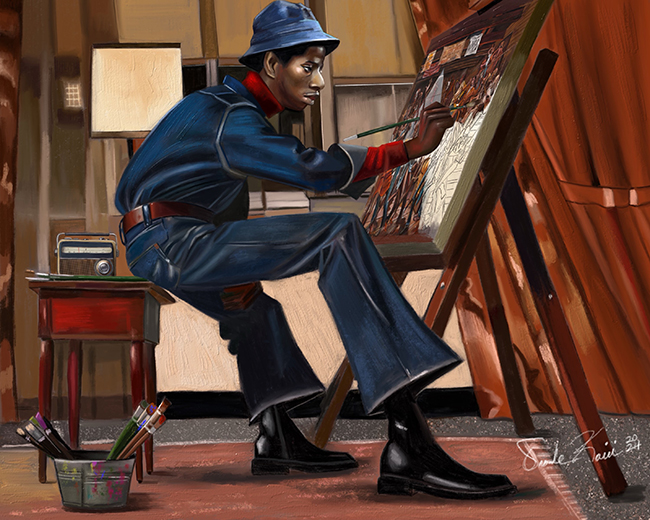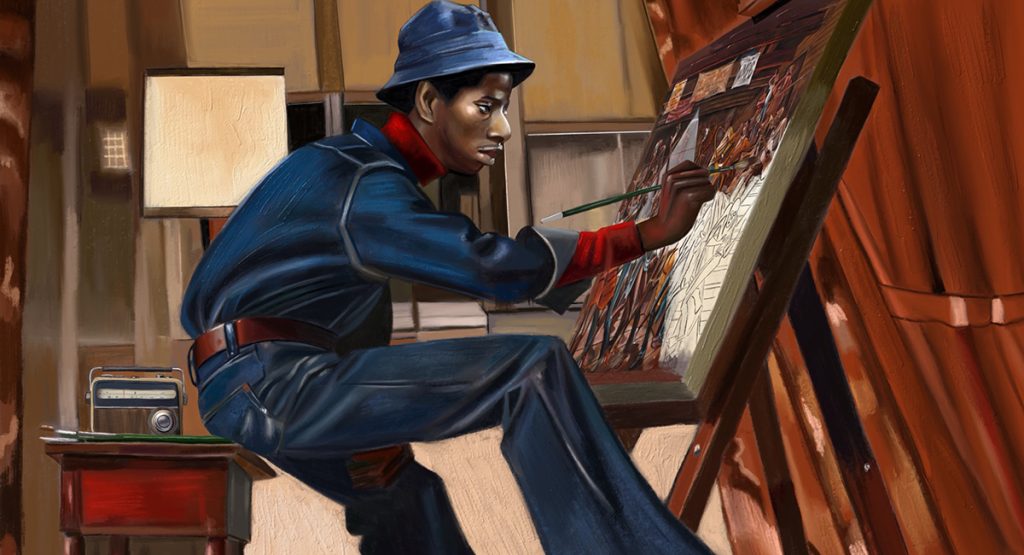Oronde Kairi, an international visual artist, brings a unique perspective to the world of contemporary art, weaving together themes of sports, music, and the intricacies of everyday life in his stylized creations. His work captures the vibrancy of human existence, with each piece telling its own narrative that resonates on a deeper, universal level. Based in the Germantown section of Philadelphia, Oronde has showcased his work in different galleries and online at www.orondekairi.com. His ability to connect his artistic vision with cultural touchstones has earned him a following that appreciates both the emotion and authenticity he brings to the canvas.

In his latest project, Oronde Kairi celebrates the 50th anniversary of the television show Good Times by paying tribute to one of its most beloved characters, JJ (James Evans Jr.), in a painting that also honors Ernie Barnes’ famous work, Sugar Shack. The scene Kairi captures is a powerful one, set in the familiar Evans family apartment. Here, JJ, known for his bold artistic ambitions throughout the series, is depicted in a more reflective moment, painting in his makeshift studio.
JJ, dressed in his signature style, leans over his canvas with intense focus, capturing the essence of the moment. The radio in the background plays, providing a soft soundtrack of soulful tunes that merge with the atmosphere of the painting. It’s a nod to the time period, evoking a sense of nostalgia for the 1970s, a decade rich with cultural shifts and movements, and a time when art was both personal and political.
Kairi’s tribute is more than just a visual homage to JJ or even Good Times; it’s a celebration of the connections between generations, television, and art itself. The show, which ran from 1974 to 1979, was groundbreaking for its portrayal of an African American family navigating life in a Chicago housing project. JJ’s character, often providing comic relief, also represented a creative spirit in a challenging environment, painting his way through life with determination and passion. Kairi brings these elements into his work, highlighting not only the character’s role in pop culture but also the enduring impact of art in communities where self-expression is essential.
The painting is filled with details that transport the viewer into the world of the Evans family. The worn furniture, the familiar patterns on the walls, and the subtle lighting create a sense of warmth, contrasting with the hardships the family faced. It’s in this space that JJ finds solace through his art, a detail Kairi captures with a quiet reverence. The act of creation, the intimate relationship between an artist and his work, is evident in the way JJ bends over his painting, completely absorbed by his craft.
In many ways, this tribute also serves as a conversation between Oronde Kairi and Ernie Barnes, whose Sugar Shackbecame iconic after it was featured in the credits of Good Times. Barnes’ painting, with its energetic depiction of a nightclub dance scene, celebrates Black culture and the joy of community. Kairi’s work echoes this sentiment, but shifts the focus to a quieter moment of creation, capturing a different aspect of the Black experience: the solitary artist at work, yet still deeply connected to the world around him through music and culture.
The choice to depict JJ painting in this specific moment, with the radio playing and the apartment as his backdrop, is a testament to Kairi’s attention to detail and his ability to weave layers of meaning into his art. It’s a reminder that while art can be a solitary endeavor, it is also shaped by the environment in which it is created. The radio playing in the background serves as a subtle reminder of the era’s influence on JJ’s work, as well as the role that music played in both the show and the broader culture of the time.
In capturing this scene, Kairi not only honors JJ as a character but also reflects on the broader role of art in life. Just as JJ found his voice through painting, Kairi’s work speaks to the power of art to transcend circumstances, creating a space where imagination and reality meet. This tribute, then, becomes more than just a celebration of a television show or an iconic artist—it’s a reminder of the enduring connection between culture, creativity, and the human spirit.
Oronde Kairi’s painting, much like the character of JJ himself, invites viewers to reflect on the importance of perseverance, creativity, and the way art can both reflect and shape the world around us.


